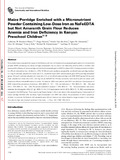Maize Porridge Enriched with a Micronutrient Powder Containing Low-Dose Iron as NaFeEDTA but Not Amaranth Grain Flour Reduces Anemia and Iron Deficiency in Kenyan Preschool Children

View/
Date
2012Author
Macharia-Mutie, Catherine W
Moretti, Diego
Briel, Natalie Van den
Omusundi, Agnes M
Mwangi, Alice M
Kok, Frans J
Zimmermann, Michael B
Brouwer, Inge D
Language
enMetadata
Show full item recordAbstract
Few studies have evaluated the impact of fortification with iron-rich foods such as amaranth grain and multi-micronutrient
powder (MNP) containing low doses of highly bioavailable iron to control iron deficiency anemia (IDA) in children. We
assessed the efficacy of maize porridge enriched with amaranth grain or MNP to reduce IDA in Kenyan preschool children.
In a 16-wk intervention trial, children (n = 279; 12–59 mo) were randomly assigned to: unrefined maize porridge (control;
4.1 mg of iron/meal; phytate:iron molar ratio 5:1); unrefined maize (30%) and amaranth grain (70%) porridge (amaranth
group; 23 mg of iron/meal; phytate:iron molar ratio 3:1); or unrefined maize porridge with MNP (MNP group; 6.6 mg iron/
meal; phytate:iron molar ratio 2.6:1; 2.5 mg iron as NaFeEDTA). Primary outcomes were anemia and iron status with
treatment effects estimated relative to control. At baseline, 38% were anemic and 30% iron deficient. Consumption of
MNP reduced the prevalence of anemia [246% (95% CI:267,212)], iron deficiency [270% (95% CI:289,216)], and
IDA [275% (95% CI:292,220)]. The soluble transferrin receptor [210% (95% CI:216,24)] concentration was lower,
whereas the hemoglobin (Hb) [2.7 g/L (95% CI: 0.4, 5.1)] and plasma ferritin [40% (95% CI: 10, 95)] concentrations
increased in the MNP group. There was no significant change in Hb or iron status in the amaranth group. Consumption of
maize porridge fortified with low-dose, highly bioavailable iron MNP can reduce the prevalence of IDA in preschool
children. In contrast, fortification with amaranth grain did not improve iron status despite a large increase in iron intake,
likely due to high ratio of phytic acid:iron in the meal.
